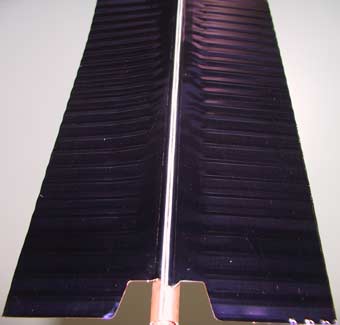solar absorber

Image courtesy of ARC Solar Inc..
The absorber is the dark-colored component of a solar collector that absorbs solar radiation and converts it to heat, or, in a solar photovoltaic device, the material that readily absorbs photons to generate charge carriers (free electrons or holes). Absorbers are usually black because dark surfaces demonstrate a particularly high degree of light absorption.
The level of absorption indicates the amount of short-wave solar radiation being absorbed (i.e., not reflected). As the absorber warms up to a temperature higher than the ambient temperature, it gives off most of the accumulated solar energy in the form of long-wave heat rays. The ratio of absorbed energy to emitted heat is indicated by the degree of emission. In order to reduce energy loss through heat emission, the most efficient absorbers have a selective surface coating. This coating enables the conversion of a high proportion of the solar radiation into heat, simultaneously reducing the emission of heat.
The usual coatings provide a degree of absorption of over 90%. Solar paints, which can be mechanically applied to the absorbers (with either brushes or sprays), are less or not at all selective, as they have a high level of emission. Galvanically applied selective coatings include black chrome, black nickel, and aluminum oxide with nickel. Relatively new is a titanium-nitride-oxide layer, which is applied via steam in a vacuum process. This type of coating stands out not only because of its quite low emission rates, but also because its production is emission-free and energy efficient.
